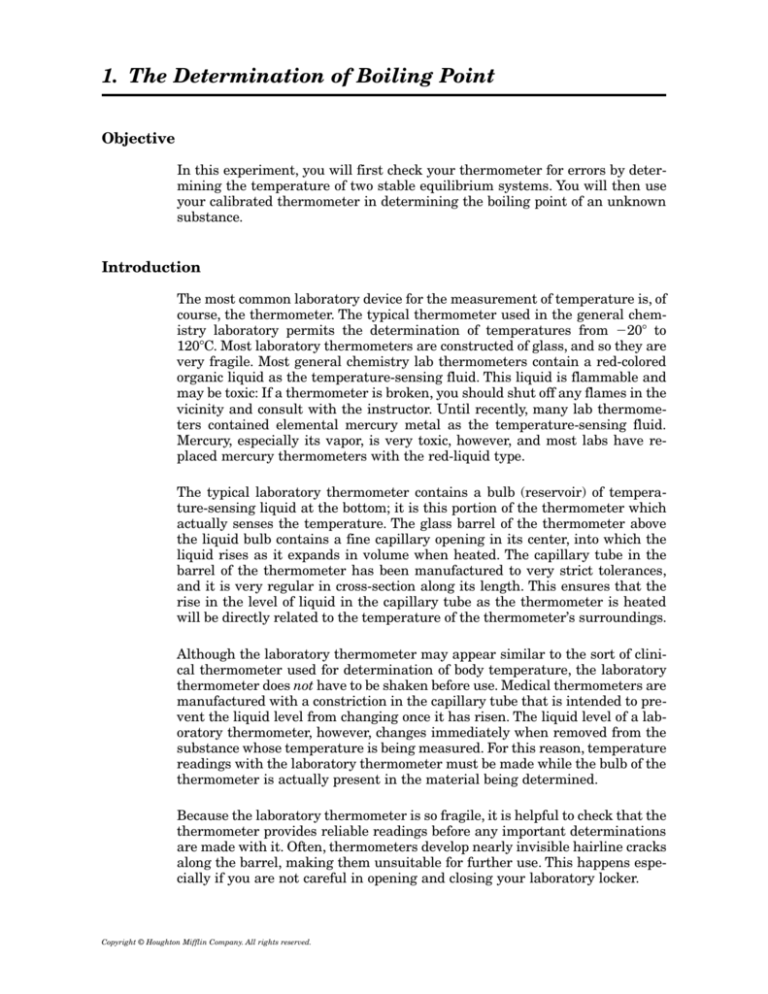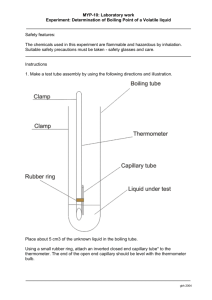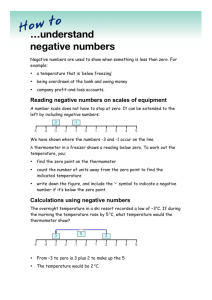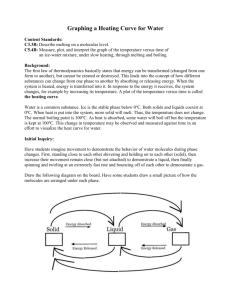
1. The Determination of Boiling Point
Objective
In this experiment, you will first check your thermometer for errors by determining the temperature of two stable equilibrium systems. You will then use
your calibrated thermometer in determining the boiling point of an unknown
substance.
Introduction
The most common laboratory device for the measurement of temperature is, of
course, the thermometer. The typical thermometer used in the general chemistry laboratory permits the determination of temperatures from 2208 to
1208C. Most laboratory thermometers are constructed of glass, and so they are
very fragile. Most general chemistry lab thermometers contain a red-colored
organic liquid as the temperature-sensing fluid. This liquid is flammable and
may be toxic: If a thermometer is broken, you should shut off any flames in the
vicinity and consult with the instructor. Until recently, many lab thermometers contained elemental mercury metal as the temperature-sensing fluid.
Mercury, especially its vapor, is very toxic, however, and most labs have replaced mercury thermometers with the red-liquid type.
The typical laboratory thermometer contains a bulb (reservoir) of temperature-sensing liquid at the bottom; it is this portion of the thermometer which
actually senses the temperature. The glass barrel of the thermometer above
the liquid bulb contains a fine capillary opening in its center, into which the
liquid rises as it expands in volume when heated. The capillary tube in the
barrel of the thermometer has been manufactured to very strict tolerances,
and it is very regular in cross-section along its length. This ensures that the
rise in the level of liquid in the capillary tube as the thermometer is heated
will be directly related to the temperature of the thermometer’s surroundings.
Although the laboratory thermometer may appear similar to the sort of clinical thermometer used for determination of body temperature, the laboratory
thermometer does not have to be shaken before use. Medical thermometers are
manufactured with a constriction in the capillary tube that is intended to prevent the liquid level from changing once it has risen. The liquid level of a laboratory thermometer, however, changes immediately when removed from the
substance whose temperature is being measured. For this reason, temperature
readings with the laboratory thermometer must be made while the bulb of the
thermometer is actually present in the material being determined.
Because the laboratory thermometer is so fragile, it is helpful to check that the
thermometer provides reliable readings before any important determinations
are made with it. Often, thermometers develop nearly invisible hairline cracks
along the barrel, making them unsuitable for further use. This happens especially if you are not careful in opening and closing your laboratory locker.
Copyright © Houghton Mifflin Company. All rights reserved.
To check whether or not your thermometer is operating correctly, you will
calibrate the thermometer. To do this, you will determine the reading given by
your thermometer in two systems whose temperature is known with certainty.
If the readings given by your thermometer differ by more than one degree from
the true temperatures of the systems measured, you should exchange your
thermometer, and then calibrate the new thermometer. A mixture of ice and
water has an equilibrium temperature of 08C, and will be used as the first
calibration system. A boiling water bath, whose exact temperature can be
determined from the day’s barometric pressure, will be used as the second
calibration system in this experiment.
Once your thermometer has been calibrated, you will use the thermometer to
determine the boiling point of an unknown liquid as a means of identifying
the liquid. The boiling point of a pure substance is important because it is
characteristic for a given substance (at a particular barometric pressure). That
is, under the same laboratory conditions, a given substance will always have
the same boiling point. Characteristic physical properties (such as the boiling
point of a pure substance) are of immense help in the identification of unknown substances. Such properties are routinely reported in scientific papers
when new substances are isolated or synthesized, and are compiled in tables
in the various handbooks of chemical data that are available in science libraries. When an unknown liquid substance is isolated from a chemical system, its boiling point may be measured (along with certain other characteristic
properties) and then compared with previously tabulated data. If the experimentally determined physical properties of the unknown match those found in
the literature, you can typically assume that you have identified the unknown
substance.
The boiling point of a liquid is defined as the temperature at which the vapor
escaping from the surface of the liquid has a pressure equal to the pressure
existing above the liquid. In the most common situation of a liquid boiling in
a container open to the atmosphere, the pressure above the liquid will be the
day’s barometric pressure. In other situations, the pressure above a liquid may
be reduced by means of a vacuum pump or aspirator, which enables the liquid
to be boiled at a much lower temperature in an open container (this is especially useful in chemistry when a liquid is unstable, possibly decomposing if it
were heated to its normal boiling point under atmospheric pressure). When
boiling points are tabulated in the chemical literature, the pressure at which
the boiling point determinations were made are also listed. The method to be
used for the determination of boiling point is a semimicro method that requires only a few drops of liquid.
The apparatus used for heating samples in this experiment is called a Thiele
tube. The Thiele tube contains oil (typically mineral oil) as a fluid, which permits the determination of temperatures up to about 2008C. The Thiele tube is
constructed in such a way that when the side arm is heated, the warm oil will
rise and enter the main chamber of the tube, which provides for circulation of
the oil and for a more uniform temperature. Samples to be placed in the Thiele
tube are ordinarily positioned so that the sample is aligned with the top
branch of the side arm. When using a Thiele tube, remember that it contains hot oil, which can be dangerous if caution is not exercised.
Copyright © Houghton Mifflin Company. All rights reserved.
SAFETY PRECAUTIONS
• Wear safety glasses at all times while in the laboratory.
• Thermometers are often fitted with rubber stoppers as an
aid in supporting the thermometer with a clamp. Inserting
a thermometer through a stopper must be done carefully
to prevent breaking of the thermometer, which would release mercury and possibly cut you. Your instructor will
demonstrate the proper technique for inserting your thermometer through the hole of a rubber stopper. Glycerine is
used to lubricate the thermometer and stopper. Protect
your hands with a towel during this procedure.
• The red liquid used as the temperature-sensing liquid in
lab thermometers is flammable. If a red-liquid thermometer breaks, extinguish all flames in the vicinity. Mercury is
poisonous and is absorbed through the skin. Its vapor is
toxic. If mercury is spilled from a broken thermometer, inform the instructor immediately so that the mercury can
be removed. Do not attempt to handle spilled mercury.
• The liquids used in this experiment are flammable. Although only small samples of the liquids are used, the danger of fire is not completely eliminated. Keep all liquids
away from open flames.
• The liquids used in this experiment are toxic if inhaled or
absorbed through the skin. The liquids should be disposed
of in the manner indicated by the instructor.
• Caution: Oil is used as the heating fluid in the Thiele tube
used for the boiling/melting point determinations that
follow. Hot oil may spatter if it is heated too strongly,
especially if any moisture is introduced into the oil from
glassware that is not completely dry. The oil may smoke or
ignite if heated above 2008C.
Apparatus/Reagents Required
Thermometer and clamp, several beakers, Thiele tube, melting point capillaries, glass tubing (5–6-mm-diameter), burner and rubber tubing, file, scissors,
medicine dropper, unknown sample for boiling point determination, ice
Procedure
Record all data and observations directly in your notebook in ink.
A. Calibration of the Thermometer
Fill a 400-mL beaker with ice, and add tap water to the beaker until the ice is
covered with water. Stir the mixture with a stirring rod for 30 seconds.
Copyright © Houghton Mifflin Company. All rights reserved.
Clamp the thermometer to a ringstand so that the bottom 2–3 inches of the
thermometer is dipping into the ice bath. Make certain that the thermometer
is suspended freely in the ice bath and is not touching either the walls or the
bottom of the beaker.
Allow the thermometer to stand in the ice bath for 2 minutes, and then read
the temperature indicated by the thermometer to the nearest 0.2 degree.
Remember that the thermometer must be read while still in the ice bath. If the
reading indicated by the thermometer differs from 08C by more than one
degree, replace the thermometer and repeat the ice bath calibration.
Allow the thermometer to warm to room temperature by resting it in a safe
place on the laboratory bench.
Set up an apparatus for boiling as indicated in Figure 1-1, using a 100-mL
beaker containing approximately 75 mL of water. Add 2–3 boiling chips to the
water, and heat the water to boiling.
FIGURE 1-1
Apparatus for
boiling. Make
certain that
the thermometer is freely
suspended in
the water
and is not
touching the
walls of the
beaker.
Using a clamp, suspend the thermometer so that it is dipping halfway into the
boiling water bath. Make certain that the thermometer is not touching the
walls or bottom of the beaker. Allow the thermometer to stand in the boiling
water for 2 minutes; then record the thermometer reading to the nearest 0.28C.
A boiling water bath has a temperature near 1008C, but the actual temperature of boiling water is dependent on the barometric pressure and changes
with the weather from day to day. Your instructor will list the current barometric pressure on the chalkboard. Using a handbook of chemical data, look up
the actual boiling point of water for this barometric pressure and record.
If your measured boiling point differs from the handbook value for the provided barometric pressure by more than one degree, exchange your thermometer at the stockroom, and repeat the calibration of the thermometer in
both the ice bath and the boiling water bath.
Copyright © Houghton Mifflin Company. All rights reserved.
B. Determination of Boiling Point
Set up a Thiele tube filled with oil as indicated in Figure 1-2. Examine the oil
to make certain that it is not cloudy or contaminated with any substance. If
the oil appears cloudy or contaminated, consult with the instructor about replacing the oil. The oil bath will be used to heat the boiling point sample
evenly. Remember that hot oil can spatter or ignite if heated too quickly or too
strongly.
FIGURE 1-2
Thiele tube
oil bath for
boiling/
melting
determinations.
Exercise
caution when
dealing with
heated oil.
Obtain a clean 10375-mm semimicro test tube, which will contain the boiling
point sample. Attach the test tube to the lower end of your thermometer with
two small rubber bands.
Obtain an unknown liquid for boiling point determination from your instructor, and record the identification code number of the unknown in your notebook and on the lab report page. Transfer part of the unknown sample to the
small test tube, until the test tube is approximately half full.
Obtain a melting point capillary. If the capillary tube is open at both ends, heat
one end briefly in a flame to seal it off. Using a glass file, carefully cut the capillary about 1 inch from the sealed end. Do not fire-polish the cut end of the
capillary. Place the small portion of capillary sealed end up into the boiling
point sample in the test tube.
The capillary has a rough edge at the cut end, which serves as a surface at
which bubbles can form during boiling. The capillary is filled with air when inserted sealed end up into the liquid, and the presence of this air can be used
to judge when the vapor pressure of the unknown liquid reaches atmospheric
pressure.
Lower the thermometer/sample into the oil bath, so that the bulb of the thermometer and the sample are level with the upper branch of the Thiele tube’s
side arm. The Thiele tube is constructed in such a manner that when the side
Copyright © Houghton Mifflin Company. All rights reserved.
arm is heated, oil will circulate from the side arm into the main chamber. This
makes it unnecessary to stir the oil bath.
Begin heating the side arm of the Thiele tube with a low flame, so that the
temperature rises by one or two degrees per minute. Watch the small capillary
tube in the unknown sample while heating. As the sample is heated, air in the
capillary tube will begin to bubble from the capillary. As the air bubbles from
the capillary, it is gradually replaced by vapor of the unknown. As the liquid
begins to boil, the bubbles coming from the capillary will form a continuous,
rapid stream. When the capillary begins to bubble continuously, remove the
heat from the Thiele tube. The liquid will continue to boil.
Watch the capillary in the unknown sample carefully after removing the heat.
The bubbling will slow down and stop after a few minutes, and the capillary
will begin to fill with the unknown liquid. Record the temperature at which the
bubbling stops. At this point (where bubbling stops), the vapor pressure of the
liquid is just equal to the barometric pressure.
Allow the oil bath to cool by at least 208C. Add additional unknown liquid to
the small test tube, as well as a fresh length of capillary tube (it is not necessary to remove the previous capillary). Repeat the determination of the boiling
point of the unknown. If the repeat determination of boiling point differs from
the first determination by more than one degree, do a third determination.
Your instructor may provide you with the identity of your boiling point sample. If so, look up the true boiling point of your sample in a handbook of chemical data. Calculate the percent difference between your measured boiling
point and the literature value.
Copyright © Houghton Mifflin Company. All rights reserved.
The Determination of Boiling Point
Date:
........................................................................
Student name:
..................................................................................................
Course:
........................................................................
Team members:
..................................................................................................
Section:
........................................................................
..................................................................................................
Instructor:
........................................................................
..................................................................................................
Prelaboratory Questions
1. Why is a mixture of ice and water, rather than ice alone, used in
calibrating a thermometer?
2. Why does the boiling point of a liquid vary with the barometric pressure?
3. Using a handbook of chemical data, find the boiling points of water at the
pressures indicated below. Give the reference for the data you list.
75 mm Hg
................................................................................................
375 mm Hg
................................................................................................
760 mm Hg
................................................................................................
799 mm Hg
................................................................................................
Reference
....................................................................................................................................................................................
Copyright © Houghton Mifflin Company. All rights reserved.
The Determination of Boiling Point
Date:
........................................................................
Student name:
..................................................................................................
Course:
........................................................................
Team members:
..................................................................................................
Section:
........................................................................
..................................................................................................
Instructor:
........................................................................
..................................................................................................
Results/Observations
A. Calibration of the Thermometer
Temperature in ice/water bath ................................................................................................................................................
Thermometer error at ice/water temperature ....................................................................................................
Temperature in boiling water ....................................................................................................................................................
Barometric pressure ................................................................................................................................................................................
True boiling point of water at this pressure
........................................................................................................
Thermometer error in boiling point of water ......................................................................................................
B. Determination of Boiling Point
Identification number of unknown liquid sample ........................................................................................
First determination of boiling point ..................................................................................................................................
Second determination of boiling point ..........................................................................................................................
Mean value for unknown boiling point ........................................................................................................................
Questions
1. What is meant by the normal boiling point of a substance?
2. Food products such as cake mixes often list special directions for cooking
the products in high-altitude areas. Why are special directions needed for
such situations? Would a food take a longer or shorter time period to cook
under such conditions? Why?
Copyright © Houghton Mifflin Company. All rights reserved.









